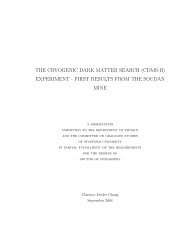Development of a Dilution Refrigerator for Low-Temperature ...
Development of a Dilution Refrigerator for Low-Temperature ...
Development of a Dilution Refrigerator for Low-Temperature ...
- No tags were found...
Create successful ePaper yourself
Turn your PDF publications into a flip-book with our unique Google optimized e-Paper software.
Type <strong>of</strong> refrigerator neededTo carry out research at low temperatures it is necessary to have a refrigerator that 1) cools tothe required temperature, 2) is reliable and, 3) if possible, operates continuously <strong>for</strong> the duration <strong>of</strong>the experiment, whether that is hours or days. On the ground the need <strong>for</strong> temperatures below 0.3K is almost universally met by the He-3-He-4 dilution refrigerator. Its usefulness arises from thefact that it operates continuously, it can provide a substantial cooling power at temperatures fromaround 1.0 K down to 0.010 K and below and it can run uninterrupted <strong>for</strong> as long as several months.There are many very interesting physics experiments that need the unique microgravityenvironment <strong>of</strong> space but which also need lower temperatures than are currently available. Inorder to investigate phenomena that occur at very low temperatures, particularly in superfluidHe-3, the capability <strong>for</strong> extending research to temperatures <strong>of</strong> 0.001 K in space needs to bedeveloped. On the ground, temperatures to 0.001 K and below are reached with adiabaticdemagnetization systems that are precooled with helium dilution refrigerators. Similartemperatures can be achieved in space if the dilution refrigerator can be adapted to work inmicrogravity.2Microgravity ResearchAn important example <strong>of</strong> microgravity research is the study <strong>of</strong> liquid He-4 and He-3, bothnormal and superfluid phases; this has been a very productive field <strong>for</strong> many years because <strong>of</strong> theunique nature <strong>of</strong> these two very different liquids. The availability <strong>of</strong> the low gravity <strong>of</strong> space is aboon to this research because gravity has a major effect upon the behavior <strong>of</strong> the liquid. At phasetransitions <strong>of</strong> the liquid, <strong>for</strong> example, the effect <strong>of</strong> gravity is to spread out the region over whichthe transition occurs. This can seriously mask important details <strong>of</strong> the transition. Otherphenomena, such as spin-spin relaxation in He-3, are strongly influenced by the surface <strong>of</strong> acontainer, and the ability to <strong>for</strong>m freely floating drops in microgravity would allow the influence<strong>of</strong> the container to be eliminated.Adapting a <strong>Dilution</strong> <strong>Refrigerator</strong> <strong>for</strong> SpaceThe helium dilution refrigerator relies on the unique properties <strong>of</strong> liquid He-3 and He-4.Cooling to 0.010 K and below is produced when He-3 atoms cross the phase boundary that existsbetween liquid He-3 and liquid He-4 at low temperatures. (Essentially, He-3 ‘evaporates’ intothe liquid He-4.) We have been studying the capabilities <strong>of</strong> a special dilution refrigerator; 1 thisrefrigerator is unusually compact and reliable, making it especially suitable <strong>for</strong> spaceapplications. On the ground, gravity provides the <strong>for</strong>ce that keeps the two liquids in theirrequired places so that the cooling can happen when and where it is needed. In space this <strong>for</strong>cecan be replaced with capillary <strong>for</strong>ces that arise when the liquids are confined in porous sponges.We have shown 2,3 that it should be possible to develop a helium dilution refrigerator that willconfine the liquids with capillary <strong>for</strong>ces and still provide the cooling that makes the dilutionrefrigerator so valuable. This approach should work even better in microgravity.We are sure that it is possible to adapt the dilution refrigerator to operate in microgravity. If thiscan be achieved, the same features that make the dilution refrigerator so attractive <strong>for</strong> laboratoryresearch would become available to researchers in space.PREVIOUS DEVELOPMENTPrinciple <strong>of</strong> Single-Cycle <strong>Dilution</strong> <strong>Refrigerator</strong>Figure 1 shows how such a refrigerator operates. The lowest temperatures occur in the mixingchamber where there is a phase boundary between liquid He-3 and liquid He-4. Cooling is producedwhen He-3 crosses this boundary into the He-4. From the mixing chamber this dilute He-3




